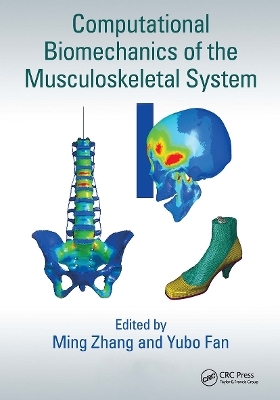
Computational Biomechanics of the Musculoskeletal System
CRC Press (Verlag)
978-1-032-92047-4 (ISBN)
Computational biomechanics is an emerging research field that seeks to understand the complex biomechanical behaviors of normal and pathological human joints to come up with new methods of orthopedic treatment and rehabilitation.
Computational Biomechanics of the Musculoskeletal System collects the latest research and cutting-edge techniques used in computational biomechanics, focusing on orthopedic and rehabilitation engineering applications. The book covers state-of-the-art techniques and the latest research related to computational biomechanics, in particular finite element analysis and its potential applications in orthopedics and rehabilitation engineering. It offers a glimpse into the exciting potentials for computational modeling in medical research and biomechanical simulation.
The book is organized according to anatomical location—foot and ankle, knee, hip, spine, and head and teeth. Each chapter details the scientific questions/medical problems addressed by modeling, basic anatomy of the body part, computational model development and techniques used, related experimental studies for model setup and validation, and clinical applications. Plenty of useful biomechanical information is provided for a variety of applications, especially for the optimal design of body support devices and prosthetic implants.
This book is an excellent resource for engineering students and young researchers in bioengineering. Clinicians involved in orthopedics and rehabilitation engineering may find this work to be both informative and highly relevant to their clinical practice.
Ming Zhang is a professor of biomedical engineering and the director of the Research Center for Musculoskeletal Bioengineering at The Hong Kong Polytechnic University. He earned a master’s degree in mechanical engineering from Beijing Institute of Technology and a PhD in medical engineering and physics from the University of London. Dr. Zhang is the secretary of the World Association for Chinese Biomedical Engineers, a member of World Council of Biomechanics, and a standing council member for the Chinese Society of Biomedical Engineering and the Chinese Rehabilitation Devices Association. Dr. Zhang has published nearly 200 journal articles and book chapters. His current research interests include computational biomechanics, bone biomechanics, foot biomechanics, body support biomechanics, prosthetic and orthotic bioengineering, human motion, and body vibration analysis. Yubo Fan is the dean of the School of Biological Science and Medical Engineering at Beihang University and director of the Key Laboratory for Biomechanics and Mechanobiology of the Chinese Education Ministry. He is current president of the Chinese Biomedical Engineering Society, vice president of Chinese Strategic Alliance of Medical Device Innovation, a member of World Council of Biomechanics, and a fellow of the American Institute for Medical and Biological Engineering. He was awarded his PhD from Sichuan University. Dr. Fan specializes in biomechanics, with particular interest in computational biomechanics, musculoskeletal and dental mechanics, cardiovascular fluid mechanics, biomaterials, and rehabilitation engineering. Dr. Fan has published more than 100 international journal articles.
Foot and Ankle Joint. Foot Model for Investigating Foot Biomechanics and Footwear Design. Female Foot Model for High-Heeled Shoe Design. Foot and Ankle Model for Surgical Treatment. First Ray Model Comparing Normal and Hallux Valgus Feet. Dynamic Foot Model for Impact Investigation. Knee Joint. Knee Joint Model for Anterior Cruciate Ligament Reconstruction. Knee Joint Models for Kneeling Biomechanics. Knee Implant Model: A Sensitivity Study of Trabecular Stiffness on Periprosthetic Fracture. Hip and Pelvis. Femur Model for Predicting Strength and Fracture Risk. Hip Model for Osteonecrosis. Pelvis Model for Reconstruction with Autografted Long Bones Following Hindquarter Amputation. Lower Limb for Rehabilitation. Foot–Ankle–Knee Model for Foot Orthosis. Lower Residual Limb for Prosthetic Socket Design. Residual Limb Model for Osteointegration. Spine. Spine Model for Vibration Analysis. Cervical Spinal Fusion and Total Disc Replacement. Spine Model for Disc Replacement. Spine Model for Applications in Aviation Protection. Head and Hand. Head Model for Protection. Tooth Model in Orthodontics and Prosthodontics. Eye Model and Its Application. Temporomandibular Joint Model for Asymptomatic and Dysfunctional Joints. Fingertip Model for Blood Flow and Temperature. Bone. Micro-Finite Element Model for Bone Strength Prediction. Simulation of Osteoporotic Bone Remodeling.
| Erscheinungsdatum | 16.10.2024 |
|---|---|
| Zusatzinfo | 237 Illustrations, black and white |
| Verlagsort | London |
| Sprache | englisch |
| Maße | 178 x 254 mm |
| Gewicht | 748 g |
| Themenwelt | Medizin / Pharmazie ► Allgemeines / Lexika |
| Medizinische Fachgebiete ► Chirurgie ► Unfallchirurgie / Orthopädie | |
| Medizin / Pharmazie ► Physiotherapie / Ergotherapie ► Orthopädie | |
| Technik ► Medizintechnik | |
| Technik ► Umwelttechnik / Biotechnologie | |
| ISBN-10 | 1-032-92047-5 / 1032920475 |
| ISBN-13 | 978-1-032-92047-4 / 9781032920474 |
| Zustand | Neuware |
| Informationen gemäß Produktsicherheitsverordnung (GPSR) | |
| Haben Sie eine Frage zum Produkt? |
aus dem Bereich


